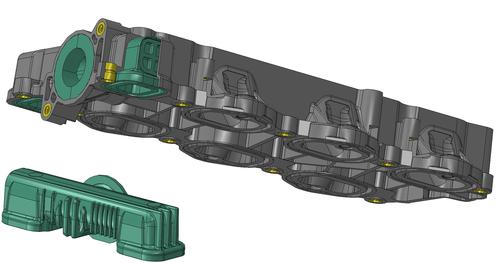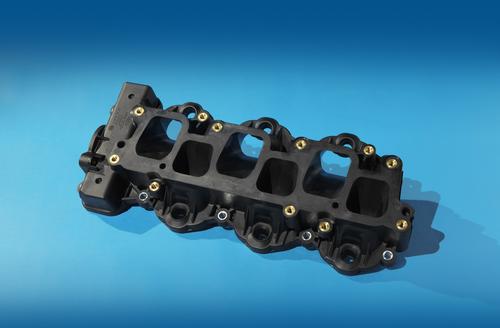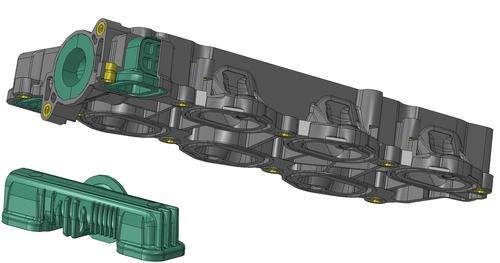Plastic Replaces Metal in Car Engine
January 13, 2014

Ford has replaced brazed metal manifold components in two new V6 engines with DuPont's Zytel HTN PPA resin, saving 1 lb. in weight and $1 in cost per engine. Because of the advances achieved with this redesign -- a collaboration among DuPont, Ford, and Illinois Tool Works -- the Society of Plastics Engineers named the team finalists for the Most Innovative Use of Plastics Award, Process/Assembly/Enabling Technology category, of the SPE's 2013 Automotive Innovation Awards.
New Ford Duratec 3.5-liter and 3.7-liter V6 engines will be equipped with an injection-molded cross-over coolant component made of Zytel HTN, replacing the previous overmolded brazed metal tubing, a DuPont spokesperson told Design News. The component allows engine coolant to bypass the manifold as it circulates through the engine.

The V6 engine manifold is made of traditional nylon polymer, but that material won't withstand long-term exposure to chemicals and heat. That's why the previous component was made of metal, although that's expensive and adds weight. Merely replacing the overmolded brazed metal tubing with a similar part made of nylon polymer wasn't sufficient. For one thing, the intense pressures during the overmolding process that integrates the hollow tube into the manifold system were damaging the component, according to a press release.
Instead, the design team chose Zytel HTN PPA. This material is often used in engine cooling components, as well as in fuel-line quick connectors, due to its resistance to heat and chemicals -- especially to long-life coolant. Team members had to figure out how to redesign the structure to integrate the Zytel cross-over coolant with the nylon engine manifold. They used Moldflow to help optimize the process, and finite element analysis to optimize the design. RJG Inc.'s mold cavity pressure-sensing technology was used to get data on the pressures that were being exerted inside the cavity during overmolding. All of this data was used to prevent the tube from being damaged during that process.

The new engine manifold containing the integrated injection-molded cross-over coolant tube will debut in Duratec 3.5-liter and 3.7-liter V6 engines as a running change for Ford Taurus, Flex, Edge, and Explorer models. Aside from the weight and cost savings, the change also reduces the number of steps required to process and machine the previous powder-coated metal component.
Zytel HTN and other types of Zytel have appeared in several automotive applications, including some under the hood. For example, Zytel LC 7000 and Zytel RS LC 4000, introduced at K2013, are used in low-pressure hose and tubing automotive applications. As we told you, they have better aging performance and superior impact strength at low temperatures than standard nylon 11 and 12. DuPont and ElringKlinger made two injection-molded oil pans for large, heavy-duty truck engines manufactured by Mercedes-Benz from Zytel HTN. Zytel HTN has also appeared in the in-wheel motor bobbins of the SIM-WIL EV from Kawasaki, Japan-based SIM-Drive Corp., unveiled in March 2012. All of these were results of the collaborative efforts DuPont is known for.
I have a hard time understanding why quality carmaker Mercedes made components for its 1995 C280 engine out of biodegradable plastic. That's what Bill Griffith told us in a recent Design News Made by Monkeys article, Biodegradable Plastic Can't Take The Heat. That is just plain weird. As I commented on that story, biodegradable plastics have no business being used under the hood. Plastics designed for those applications require a very different set of specs from what's achievable with biodegradable materials. I think the engineers at Mercedes should have called DuPont.
Related posts:
About the Author(s)
You May Also Like

.jpg?width=300&auto=webp&quality=80&disable=upscale)

